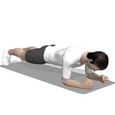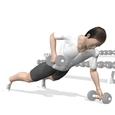The Best Six-Pack Ab Exercises
Mar 2nd, 2010 - written by Stephan in Strength Training
(0 comments)
At first glance, the best and most effective six-pack ab exercise won´t be recognized as abdominal-specific, because it isn´t the classic and very popular exercise like crunches, leg raises or sit-ups that I´m talking about. Obviously, even crunches don´t offer a really functional core training, hence there are much smarter ways to train and shape the center of your body.
Six-pack Abs Requirements
To get six-pack abs, you have to meet two essential requirements:| Muscles | Strong core muscles are the basis, not just for good-looking abs, that is nothing more than a pleasant side-effect, but for a pain-free back, a good posture and an outstanding training performance, which requires the core muscles to be as strong as possible. |
|---|---|
| Body Fat | Men need to have a body fat percentage of 10% or lower to show a six-pack ab. Otherwise they remain hidden below a layer of body fat. That, however, means no functional disadvantages at all, you simply don´t have visible abs. |
Complex Training vs. Isolation Training
Currently, the most popular ab exercises are isolation exercise that involve certain rolling-in movements of the upper body, which is no functional way to train your abs. The main purpose of all core muscles is to stabilize the trunk against external forces. Beside stabilization, the obliques serve as torso rotator. Let me summarize:Isolated core training through upper body roll-ins or side-bends is a meaningful act, but does not provide a functional and natural way of core strengthening.
Also the percentage of body fat, as the second important pillar for a six-pack abs, can be influenced more effectively by doing functional and complex exercises, since you activate a large number of muscles simultaneously. This leads to an increased hormone secretion and increased fat burning. A reduction in body fat requires a certain amount of active muscle and an adequate diet, which leads to insight number two:
The more muscles you activate simultaneously during an exercise and the more muscle mass you own, the higher your potential for burning body fat. Therefore you have to do complex exercises, requiring a signficant and functional participation of your core muscles.
The List: The Best Six-pack Ab Exercises
I will divide this list into two categories:- Ab Exercises whose target muscles are mainly abs.
- Non-Ab Exercises that activate a large number of muscles and put high demand on your core muscles.
Ab Exercises
Non-Ab Exercises
... read more
Drinking Wine Helps Women Keeping Their Bodyweight
Mar 9th, 2010 - written by Stephan in Nutrition
(0 comments)
A recently published 13 year study of more than 19.000 woman revealed that drinking alcohol regularly in moderate amounts can prevent women from becoming obese.

Wine tasting. Image credit by _olasso / Redwine. Image credit by Habub3
This perception stands in contrast to deep-rooted dietary advices claiming that alcohol consumption leads to gain weight.
According to researches the body uses calories from alcohol in a different way, which positively affects the fat metabolism. Alcohol broken down by the liver is creating heat instead of body fat.
During the study 19.220 woman were questioned about their drinking habits. About 38 per cent did not drink alcohol at all. However, this group gained the most weight. The more alcohol women consumed, the less weight they gained.
Especially woman who drank red wine gained the least weight, while drinking beer and spirits lead to higher weight gains. The study report claimed that there was no significant connection between alcohol consumption and weight gain.
"Of course if women were drinking more than two units a day they would put on weight. What this survey shows is that moderation is key to a healthy lifestyle. People who drink wine may be more likely to snack on sugary and more calorific treats."
Ultimately it is a question of the right doses. Drinking red wine in moderate amounts has already been declared as beneficial for health years ago. All I would like to know is, whether the positive effects on bodyweight also apply for men.
Sources: Archives of Internal Medicine / www.telegraph.co.uk
... read more
10 Simple Strategie For Gaining Muscle Mass
Mar 18th, 2010 - written by Stephan in Strength Training
(0 comments)
1. Increased Muscular Tension
The conscious flexion of the working muscles over the entire range of motion causes an increased muscular stimulation. This technique particularly suits isolation exercises.
Thus, for example when doing Arm Curls, an extra tightening of the arm flexing muscles at the end of the concentric phase will increase the stimulus to the biceps.
In general, the eccentric part of a movement should be done slowly and deliberately under high muscular tension, which in turn leads to a higher training level, a more intense workout and an improved development of strength and muscle mass.
2. Final Contractions
Final contractions can lead to up to 30% increased muscular stimulation. Simply do 3-5 partial repetitions with almost extended joint positions after finishing a set.For example, after the last repetition of the lat pull-down exercise, before dropping the weight, do a few repetitions in the upper part of the movement. You can apply this technique to almost any strength exercise.
3. Train Complex
A high and complex effort, and thus progressively higher workload is critical to muscular development.You can move the highest weights during basic compound exercises that stimulate many muscles simultaneously and that involve functional movements.
| Complex Exercises For The Upper Body | Complex Exercises For The Lower Body |
|---|---|
|
|
4. Train Standing
Try to do as many exercises as possible in standing position, because it requires and triggers the development of a larger number of stabilizing muscles, especially core muscles.It is important to keep up a correct training technique and to avoid any swinging. This is particularly suitable for the training of the shoulders and arms, for example, Shoulder Presses with Barbell or Dumbbells, Lateral Raises, Arm Curls and Triceps Extension.
3. Variation: Heavy - Light - Heavy
To build muscles, it is important to use heavy weights and to train a the range of 5-8 repetitions.However, muscles need some training variety to constantly develop and to grow.
Switch between heavy load training on the one hand and training with lighter weights on the other. Performing many repetitions with relatively light weights leads to better blood circulation within the affected muscles, resulting in an improved oxygen and results nutrient supply and thus promotes muscle growth.
A very simple and effective method is a permanent heavy weight training in combination with a once per weekly high-rep workout for all major muscle groups.
5. Effective Resting
In order to complete the necessary training volume in minimum time you may want to take advantage of the breaks between sets.Here you either train the corresponding antagonist or any weaknesses, such as Calves or Abdominal Muscles.
Short and intense workouts cause a higher production of hormones that are involved in muscle building.
6. Eat More
To gain weight, you need to take in more energy than you consume. Therefore you need to eat more and you need to eat the right food.To maximize the calorie intake eat mainly foods with a high energy density. Foremost amongst these are healthy fats such as olive oil, canola oil, nuts and peanut butter.
In addition, a sufficient supply of proteins is important. If you cannot meet the daily requirements through diet, it makes sense to resort to supplements, such as protein shakes.
If you are not able to take in large enough amounts of calories through solid food, you need to drink more energy-dense fluids. Drink plenty of milk, preferably whole milk, since the combination of protein and a little more fat leads to a longer digestion time in the stomach, and thus provides more energy of a longer time. Otherwise, high-calorie juices and self-made smoothies, such as milk with oatmeal and fruits, prepared in mixer, are an excellent source of energy.
7. Drink More
Muscles consist to 65% of water. Your muscles won´t grow without a sufficient water supply.The complete protein and fat metabolism is based on an adequate fluid intake. To effectively build muscle mass, you need to dink 1 liter of water per day per 20 kg of body weight.
8. Rest More
Reduce the calorie consumption besides the strength training to a minimum. Avoid long cardio units.Train hard and be lazy for the rest of the day. To ensure a good recovery and muscle growth you need to sleep about 8 hours per night.
9. Eat Directly After Training
After each intense workout, the muscles are hungry for glycogen and amino acids. Fulfill these needs promptly.To make the most of the time window of about 15 minutes, you should either have a full meal, or alternatively drink a whey protein shake together with with rapidly digestible carbohydrates.
10. Think BIG
Ultimately, it is important to be convinced of your own performance and muscle growth.Imagine to already own the desired muscles. Visualize it every day. The right mental cinema provides the necessary motivation.
Set the right priorities in terms of muscle building and developing a certain unwillingness to compromise, that is do everything necessary to reach your goal and to avoid any actions that prevent you from growing muscles.
... read more
Chocolate Can Cut Blood Pressure and Help Heart
Mar 30th, 2010 - written by Stephan in Nutrition
(0 comments)

Image credit by mwboeckmann
How great!!!
According to BBC News consuming chocolate in moderate amounts can help lowering your blood pressure.
They say that people who eat half a bar of chocolate per week had lower blood pressure and a 39% lower risk of heart attacks and strokes.
Eating much more chocolate on the other hand is bad for your health because of the high caloric density and the saturated fats that come with it.
In order to remain healthy, chocolate must not increase your overall calorie intake.
Unfortunately they left the most important question unanswered:
- Who´s eating just half a bar of chocolate? per week?
Some time ago I´ve learned that once per week you can eat whatever you like to in random amounts, because the stomach has limited capabilities of digesting plenty of food at once. Therefore I´m quite sure it is okay to even eat the whole bar, isn´t it?
Click here to read the full article.
Source: BBC News UK
... read more












